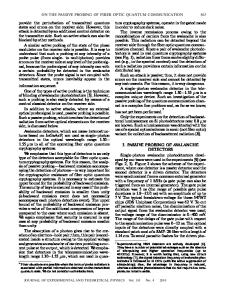Migrating customers to new distribution channels: The role of communication
- PDF / 146,376 Bytes
- 13 Pages / 595 x 765 pts Page_size
- 30 Downloads / 341 Views
Dan Sarel is an associate professor of Marketing at the University of Miami (Florida) specialising in marketing strategy and implementation in the financial services industry. Dr Sarel has over 20 years of consulting experience in the services marketing field. As a prolific researcher his publications have appeared in a range of journals including the Journal of Marketing, Journal of the Academy of Marketing Science and the Journal of Financial Services Marketing.
Howard Marmorstein is an associate professor of Marketing at the University of Miami (Florida). His research focuses on consumers’ financial decision-making behaviour and response to marketing communications. He has received two National Awards for his research on consumer behaviour and his publications have appeared in a range of journals including the Journal of Consumer Research, Journal of Marketing Research and the Journal of Business and Psychology
Abstract Banks throughout the world are making substantial investments in technology to reduce the cost of distributing their products and services to customers. It is, however, becoming increasingly clear that the desired reduction in operating expenses is not being achieved. This paper highlights the need for banks to recognise that effective communication is critical for persuading consumers to adopt the new technology. It then presents an approach for selecting a cost-effective method for migrating customers to a new service technology. An empirical study at a large US bank that utilised the proposed approach and benefited from the systematic investigation of this issue is then described. Implications for financial service providers are provided. Keywords Bank delivery channels, bank distribution channels, consumer adoption of new technologies, measuring communication effectiveness
INTRODUCTION
Dr Dan Sarel Department of Marketing, School of Business Administration, University of Miami, PO Box 24817, Coral Gables, Florida 33124-6554, USA. Tel: +1 (306) 284 1772; Fax: +1 (306) 284 5326; e-mail: [email protected]. miami.edu
254
In the past two decades, financial service firms from Boston to Bangkok1 have made large-scale, ongoing investments in automation to reduce the cost of distributing their products and services to customers. The two principal, interrelated forces underlying this pervasive trend are readily apparent. The advent of new technologies, which held out the promise of delivering funds, information and even advice, outside of the expensive branch network was the enabling force. This
Journal of Financial Services Marketing
Vol. 6, 3, 254–266
precondition, coupled with the firms’ objective of increasing profitability more rapidly than revenues could be grown, provided a compelling rationale to pursue cost savings by investing in the new technologies. Automated teller machines, centralised phone systems, kiosks, minibranches and the Internet have all been adopted by banks to deliver service to customers in ways that are less costly than through human means inside their existing brick-and-mortar
Data Loading...











